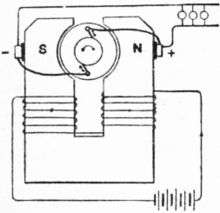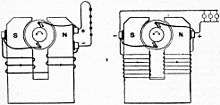Shunt generator
A shunt generator is a type of direct current electric generator in which field winding and armature winding are connected in parallel, and in which the armature supplies both the load current and the field current. A direct current (DC) generator, not using a permanent magnet, requires a DC field current for excitation. The field may be separately excited by a source of DC, such as a battery, or self excited by being connected to the armature of the generator so that the generator also provides the energy required for the field current.[1]


Series on left, shunt on right
Generator field connections
A shunt field (and any series resistor used for adjustment) may be directly connected across the armature terminals in parallel with the load. Where the machine has a series compounding winding, the field may be connected at the armature side (short shunt) or load side (long shunt). The different connections give different voltage regulation characteristics on load. So as it is connected in shunt it has constant characteristics.
Characteristics
Current in the field windings of a shunt-wound generator is (approximately) independent of the load current, because currents in parallel branches are independent of each other. Since field current, and therefore field strength, is little affected by load current, the output voltage remains more nearly constant than does the output voltage of a series-wound generator.
There will be a small armature voltage drop on load, which will be reflected in the voltage applied to the shunt field. The output voltage in a DC shunt-wound generator drops slightly as load current increases because of the voltage drop across the armature resistance.
Compound winding
In a shunt-wound generator, output voltage varies inversely with load current. In a series-wound generator, output voltage varies directly with load current. A combination of the two types can overcome the disadvantages of both. This combination of windings is called a compound-wound dc generator.[2]
See also
References
- "The Principles of the Dynamo".
- Everyman's Encyclopaedia, 1932, volume 5, page 248